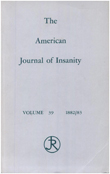SPECT findings on psychosis in Alzheimer's disease
Abstract
OBJECTIVE: This study examined whether psychosis in Alzheimer's disease is associated with cerebral perfusion patterns appreciable by single photon emission computed tomography (SPECT) scans. METHOD: All cooperative outpatients enrolled in an Alzheimer's disease research center with the diagnosis of probable Alzheimer's disease and a Clinical Dementia Rating of mild or moderate were interviewed with their primary caregivers. Current and past psychiatric functioning was assessed by using the Hamilton Depression Rating Scale, the Structured Clinical Interview for DSM-III-R, and the Behavioral Pathology in Alzheimer's Disease Rating Scale. Patients without premorbid psychosis received SPECT scans, and the scans of the patients with delusions or hallucinations (N = 30) were compared to the scans of patients without these symptoms (N = 16). RESULTS: The patients with delusions (N = 29) had hypoperfusion of the left frontal lobe in relation to the right frontal lobe. The patients with hallucinations (N = 10) had hypoperfusion in the parietal lobe. CONCLUSIONS: Psychotic patients with Alzheimer's disease had a pattern of cerebral blood flow deficits significantly different from that of nonpsychotic patients. This suggests that patterns of cerebral dysfunction may be expressed symptomatically as psychosis.
Access content
To read the fulltext, please use one of the options below to sign in or purchase access.- Personal login
- Institutional Login
- Sign in via OpenAthens
- Register for access
-
Please login/register if you wish to pair your device and check access availability.
Not a subscriber?
PsychiatryOnline subscription options offer access to the DSM-5 library, books, journals, CME, and patient resources. This all-in-one virtual library provides psychiatrists and mental health professionals with key resources for diagnosis, treatment, research, and professional development.
Need more help? PsychiatryOnline Customer Service may be reached by emailing [email protected] or by calling 800-368-5777 (in the U.S.) or 703-907-7322 (outside the U.S.).



